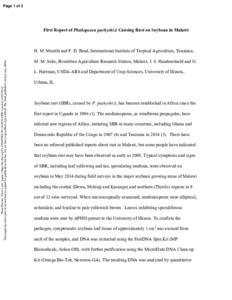| dc.contributor.author | Murithi, H. |
| dc.contributor.author | Beed, Fen D. |
| dc.contributor.author | Soko, M. |
| dc.contributor.author | Haudenshield, J. |
| dc.contributor.author | Hartman, G. L. |
| dc.date.accessioned | 2019-12-04T11:03:29Z |
| dc.date.available | 2019-12-04T11:03:29Z |
| dc.date.issued | 2015 |
| dc.identifier.citation | Murithi, H., Beed, F., Soko, M., Haudenshield, J. & Hartman, G.L. (2015). First report of Phakopsora pachyrhizi causing rust on soybean in Malawi. Phytopathology, 105(7), 905-916. |
| dc.identifier.issn | 0191-2917 |
| dc.identifier.uri | https://hdl.handle.net/20.500.12478/1101 |
| dc.description.abstract | Soybean rust (SBR), caused by Phakopsora pachyrhizi, has become established in Africa since the first report in Uganda in 1996 (2). The urediniospores, as windborne propagules, have infested new regions of Africa, initiating SBR in many countries, including Ghana and Democratic Republic of the Congo in 2007 (4) and Tanzania in 2014 (3). No refereed reports have been published about rust in Malawi, but some people have indicated that soybean rust may have been observed as early as 2008. Typical symptoms and signs of SBR, including leaf yellowing and tan, sporulating uredinia, were observed on soybean in May 2014 during field surveys in the major soybean-growing areas of Malawi, including the central (Dowa, Mchinji, and Kasungu) and southern (Thyolo) regions in nine out of 12 sites surveyed. When microscopically examined, urediniospores were elliptical, echinulate, and hyaline to pale yellowish brown. Leaves exhibiting sporuliferous uredinia were sent by APHIS permit to the University of Illinois. To confirm the pathogen, symptomatic soybean leaf tissue of approximately 1 cm2 was excised from each of the samples, and DNA was extracted using the FastDNA Spin Kit (MP Biomedicals, Solon, OH), with further purification using the MicroElute DNA Clean-up Kit (Omega Bio-Tek, Norcross, GA). The resulting DNA was analyzed by quantitative PCR using published Taqman assays for P. pachyrhizi and P. meibomiae, with a multiplexed exogenous internal control reaction to validate negative results (1). P. pachyrhizi DNA was detected in excess of 180,000 genome equivalents/cm2 in all samples, indicating a substantial infection. P. meibomiae DNA was determined to be absent from all samples, within the limit of quantification of ~2 pg DNA/cm2. Urediniospores dislodged from three leaves and inoculated onto susceptible soybean cultivar Williams 82 produced tan lesions after 2 weeks of incubation in a detached-leaf assay. This is the first confirmed report of P. pachyrhizi causing rust on soybean in Malawi, putting at risk 14,000 ha currently under soybean production. The reports of soybean rust in Malawi and adjoining countries will alter soybean production practices and research interests. In some cases, foliar application of fungicides has increased and planting dates have been changed to avoid conditions that are most conducive for rust development. Efforts to understand the virulence and genetic diversity of the pathogen in the region are needed in order to develop and deploy resistant cultivars. |
| dc.language.iso | en |
| dc.subject | Soyabean |
| dc.subject | Phakopsora Pachyrhizi |
| dc.title | First report of Phakopsora pachyrhizi causing rust on soybean in Malawi |
| dc.type | Journal Article |
| dc.description.version | Peer Review |
| cg.contributor.affiliation | International Institute of Tropical Agriculture |
| cg.contributor.affiliation | Bvumbwe Agriculture Research Station, Malawi |
| cg.contributor.affiliation | University of Illinois |
| cg.coverage.region | Africa South Of Sahara |
| cg.coverage.country | Malawi |
| cg.isijournal | ISI Journal |
| cg.authorship.types | CGIAR and developing country institute |
| cg.iitasubject | Grain Legumes |
| cg.iitasubject | Soybean |
| cg.journal | Plant Disease |
| cg.howpublished | Formally Published |
| cg.accessibilitystatus | Limited Access |
| local.dspaceid | 78099 |
| cg.identifier.doi | https://dx.doi.org/10.1094/PDIS-09-14-0924-PDN |

